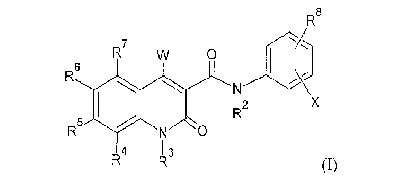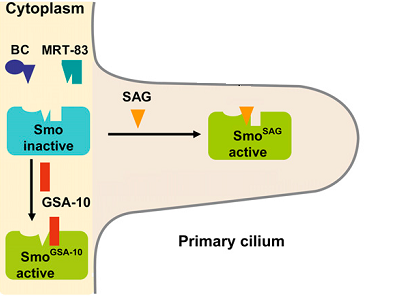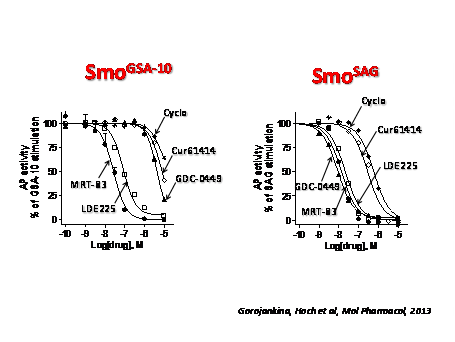Uses of quinolinones derivatives as a research tool
Référence
03764-01
Mots-clés
Statut des brevets
French patent application FR1004444 filed in November 16th, 2010 and entitled “Use of quinolinone derivatives as a research tool”




Inventeurs
Martial RUAT
Statut commercial
Exclusive license
Laboratoire
Neurobiology and Development Laboratory (UPR3294), CNRS, in Gif-sur-Yvette, France.
Description
CONTEXT
The present invention relates to the use of quinolinone derivatives of general formula (I) , ligands of the Smo receptor or of related receptors which target a binding site of the receptor which is different from the know ligand binding sites. These quinolinone derivatives can be used as research tools for identifying modulators of the Smo receptor or of related receptors, characterizing the Hedgehog signaling pathway and diagnosis.

TECHNICAL DESCRIPTION

SAG stabilizes an active form in the primary cilium named SmoSAG. MRT-83 potently blocks GSA-10 and SAG-induced activity.

The potent Smo antagonist MRT-83 (Roudaut et al.,2011; Solinas et al., 2012) displayed a similar potency to block GSA-10 (1 mM) and SAG (0.1 mM) response (IC50, ~38 and 11nM, espectively) GSA-10 and SAG Exhibit Distinct Pharmacology at Smo. investigated the site of action of these molecules at Smo. Inhibition of Bodipy-cyclopamine (BC) binding to Smo has been used as an assay for the identification of Smo modulators, including both agonists and antagonists (Chen et al., 2002; Sinha and Chen, 2006). Thus, the GSA-10 potential inhibition of BC binding to human Smo (hSmo) stably expressed in HEK293 cells (HEK-hSmo) was investigated and compared with the one of SAG (Roudaut et al., 2011). As expected, SAG (3 mM) inhibited BC binding to Smo, and GSA-10 did not, even at 30 mM, a concentration 25-fold higher than its EC50 (Fig. 7A).
These data indicate that GSA- 10, unlike SAG, does not compete with the BC site at Smo.We then tested whether the differentiation of C3H10T1/2 cells observed after addition of GSA-10 and SAG could be blocked by antagonizing Smo. The concentration of SAG and GSA-10 used in these experiments was near their respective EC50. The potent Smo antagonist MRT-83 (Roudaut et al., 2011; Solinas et al., 2012) displayed a similar potency to block GSA-10 (1 mM) and SAG (0.1 mM) response (IC50, ~38 and 11 nM, respectively) (Fig. 7, B and C). MRT-83 showed a competitive antagonism at both molecules. Increasing concentrations of GSA-10 and SAG led to a progressive rightward shift in the MRT-83 inhibition curves and an approximately 3–6-fold increase in their IC50 (Fig. 7, B and C). The ability of MRT-83 to competitively inhibit GSA-10– and SAG-mediated AP response is consistent with a direct action of each molecule on Smo for pathway activation.
The pharmacological characterization of SAG and GSA-10 agonist sites, called here SmoSAG and SmoGSA-10, respectively (Fig. 8), was then performed using a panel of potent Smo.
BENEFITS
- To identify selective modulators of Smo targeting SmoSAG or SmoGSA-10
- Well identified target ;
- MRT-83 AND MRT-72 are among the more potent Smoothened antagonists reported so far and are easy to synthesize ;
- MRT compounds may also be of interest for treating other Hedgehog linked cancers.
INDUSTRIAL APPLICATIONS
For further information, please contact us (Ref 03764-01)
Besoin de plus d'informations ?
Nous contacterTechnologies Liées
-
08.02.2017
Method for determining the size distribution of a mixture of particles of (macro)molecules using taylor dispersion and associated system
Chimie, Santé / Thérapeutique, Diagnostic médical, Matériaux – Revêtements 00957-03
-
09.03.2015
A new validated series for the diagnosis and therapeutic follow-up of Alzheimer’s disease and its potent treatment via alpha-7 nicotinic receptors binding/agonism
Santé / Thérapeutique, Diagnostic médical 04009-01
-
18.02.2015
A potential first-in-class drug for the treatment of leukemia
Santé / Thérapeutique 06043-01